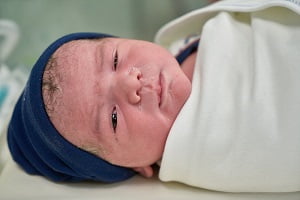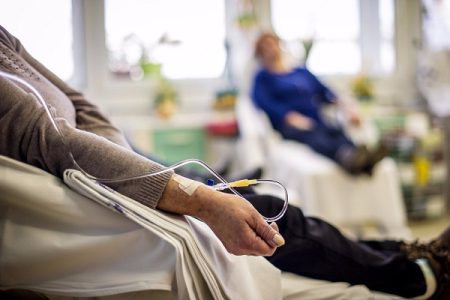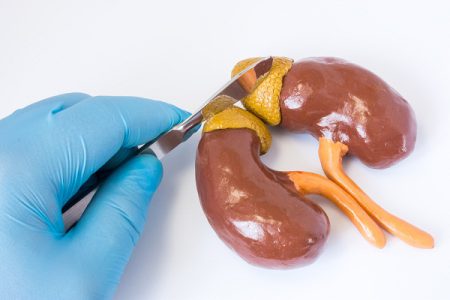Side Effects and Late Effects of Neuroblastoma Treatment
- Updated on: Jul 8, 2024
- 6 min Read
- Published on Feb 25, 2020

Neuroblastoma is a rare disease characterized by uncontrolled or abnormal cell growth resulting in the formation of a lump or mass called solid tumor. Normally, the immature cells in neuroblasts grow and divide to form nerve cells whereas in neuroblastoma they form cancer cells resulting in various signs and symptoms.
The typical treatment for neuroblastoma includes different treatment procedures such as surgical removal of a tumor, radiation therapy, and chemotherapy. If the tumor is confined to its origin and has not spread to other parts of the body, surgery is enough for removing the tumor from the body.
Children who undergo three or more kinds of treatment for neuroblastoma are at risk of developing severe side effects and late effects of the treatment.
Side effects of the treatment affect various healthy tissues and organs. Late effects of the treatment continue for several months and years. However, the side effects and late effects of the neuroblastoma treatment vary among different persons receiving the same type of cancer treatment.
What are the Late Effects of Neuroblastoma Treatment in Children?
Parents often worry about the late effects of neuroblastoma treatment in their children that may immediately develop after the treatment has ended and may last several months or years. Some children suffer from different side effects or late effects of the neuroblastoma treatment while others do not suffer much. Possible side or late effects of the treatment of neuroblastoma in children generally depends upon the following:
- The type of treatment undergone by the children
- The number of treatment doses received by children
- The age of children at the time of treatment
Children suffering from neuroblastoma often undergo different treatments for getting rid of their cancers and each treatment method has its possible side effects.
The side effects of neuroblastoma depend upon the stage of the disease and the type of treatment. For example, children with low-risk neuroblastoma are mainly treated with surgery and do not develop many side effects. On the contrary, children with high-risk neuroblastoma require multiple treatments including chemotherapy, radiotherapy, surgery, and stem cell transplantation, etc and are therefore at higher risk of developing the side effects of the treatment.
Following are some of the late effects of the neuroblastoma treatment in children:
- Learning Difficulties
- Visual problems
- Reproductive system problems
- Bladder problems
- Problems in hearing
- Changes in kidney functioning
- Changes in functioning of the heart
- Growth related issues
- Chances of recurring of the cancer
- Bone and muscle-related problems such as scoliosis (curving of the spine)
- Thyroid related issues
- Emotional or psychological disturbances
- Neurological issues
- Opsoclonus myoclonus syndrome (A condition where the body’s immune system attacks the normal nervous tissues) which may lead to various problems like learning disabilities, language problems, delays in muscle development, and behavioral problems.
- Delays in muscle development
- Growth hormone deficiency
- Dental issues
- Cardiovascular problems including weakening of heart muscles
- Risk of developing other cancers
- Pulmonary dysfunctioning
Learning Difficulties
Some children suffer from certain learning difficulties after the neuroblastoma treatment. These may include:
- Poor academic performance
- Difficulty in memorizing things and paying attention
- Poor hand-eye coordination
- Behavioral problems
- A decrease in IQ levels about 10 to 20 points
Vision Problems
Following are some vision problems that may occur in children after neuroblastoma treatment:
- Dryness in the eyes
- Irritation in the eyes (feeling of something stuck in the eyes)
- Discoloration of the sclera (white part of the eye may become yellow)
- Reduced vision
- Sensitivity to light
- Eyelid tumors
- Poor night vision
- Drooping eye lids
- Damage to the optic nerve and retina
Growth and Developmental Issues
After neuroblastoma treatment, some children undergo the following growth and developmental issues:
- Low growth rate leading to short stature which may be either temporary or permanent
- Decreased bone growth especially in the areas being treated
The changes in growth rate are short-term if patients are given chemotherapy alone without radiation therapy. However, certain chemotherapy drugs given in high doses may produce long lasting effects on the growth rate of the child.
Bone Related Complications
Radiation therapy may impair the growth of bones and muscles in infants and children (the bones, soft tissues, muscles, and blood vessels of children and infants are in growing phase) which makes them sensitive to radiation.
Following bone and muscle-related issues may be found in children due to neuroblastoma treatment:
- Unequal growth of the body parts i.e., the treated side of the body grows differently compared to the untreated side
- Stiffness of joints
- Pain in the bones
- Weak bones which make them easily susceptible to osteoporosis
- Low calcium levels in the bones
- Gait changes (changes in the way the child walks)
Cardiovascular Problems
Radiation therapy to the chest in neuroblastoma survivors may lead to many cardiovascular problems such as weakening of heart muscle, scarring of the heart muscle, etc.
The chemotherapy drug doxorubicin (Adriamycin) may cause many heart-related issues in patients after the treatment. Doctors often recommend regular checkups and physical examinations like ECG, Ultrasound, and blood pressure monitoring after the treatment so that they can immediately monitor the heart problems and start the treatment if required.

 Bladder Problems
Bladder Problems
Some chemotherapy drugs may cause many bladder problems after the treatment is over. Most commonly drugs like cyclophosphamide (Cytoxan, Procytox) and ifosfamide (Ifex) are responsible for various bladder-related issues like hemorrhagic cystitis (inflammation and bleeding of the bladder) which may occur immediately a few weeks post-chemotherapy.
Kidney Problems
Kidney problems are found in children who have undergone a stem cell transplant or chemotherapy including cisplatin as a part of the regimen.
Regular kidney function tests may be recommended for checking the kidney function and also electrolyte supplements including magnesium, calcium, potassium or phosphate may be given on a temporary basis.
Reproductive System Problems
The drugs used in chemotherapy for neuroblastoma cancers especially alkylating agents may affect the ovaries or testicles of the children as they grow older and result in different reproductive issues which may include:
- Early or later onset of puberty than average
- Premature menopause in girls
- Problems in pregnancy due to damaged ovaries
- Infertility
Long Term Side Effects of Treatment in Neuroblastoma Survivors
It has been analyzed by the researchers that neuroblastoma survivors are at a higher risk of mortality and secondary malignancies, and also at an increased risk of developing chronic health conditions.
The most common chronic health conditions that may occur in the children who are neuroblastoma survivors include:
- Endocrine problems
- Sensory issues/hearing loss
- Bone Disorders
Endocrine Problems
Endocrinopathies are the most common complications of neuroblastoma treatment especially in children who are high-risk neuroblastoma survivors and have undergone a multimodality treatment. High-risk neuroblastoma patients treated with high-dose chemotherapy along with autologous stem cell transplant (without using total body irradiation (TBI)), develop endocrine-related late effects such as primary hypothyroidism, growth failure, and hypogonadism.
Following are some of the common endocrine-related side effects of neuroblastoma treatment in survivors:
- Thyroid dysfuctioning
- Hypogonadism and impaired fertility
- Diabetes and metabolic syndrome
Hearing loss/Ototoxicity
High-risk neuroblastoma survivors may suffer from hearing loss particularly those treated with platinum-based chemotherapy. Besides, exposure to ototoxic antibiotics during chemotherapy likely increases the risk of ototoxicity related hearing loss.
It has been suggested that neuroblastoma survivors with hearing loss are at increased risk for developing various learning problems and psychosocial impairments. Therefore, neuroblastoma survivors must be screened for ototoxicity and referred for hearing services and hearing aids, if detected early.
Bone Disorders
Children who are neuroblastoma survivors often develop some musculoskeletal disorders after radiation therapy. Spine can be affected by radiation therapy which results in short stature.
Radiation therapy in the chest and neck areas may cause narrowing of shoulders, poorly developed chest, and a narrower neck.
Management of Late Side effects of Neuroblastoma Treatment
After the treatment for neuroblastoma is over, it is very obvious that there will remain certain side effects of the treatment. In such cases, the following steps should be taken that may help you in managing the child’s side effects:
- Regular health checkups for avoiding the recurrence of cancer
- Screening and monitoring of serious side effects for avoiding serious complications
- Exercising regularly for staying healthy and relaxing your body
- Getting vaccinated against various infections as the immune system of neuroblastoma survivors becomes weak post-treatment due to the high-intensity radiations used in chemotherapy
- Girls should go for gynecologic examinations at least once in a year for avoiding reproductive issues
- Hearing tests should be done
- Blood tests for checking the functioning of different organs especially the ones affected by cancer treatment
- Going to survivorship clinics that may provide value-based care to cancer survivors and also a survivorship care plan
- Modifying lifestyle such as quitting smoking, avoiding use of illegal drugs, and avoiding the use of alcohol












